Logitech MX Revolution: New Technology means a Smarter Mouse
by Gary Key on September 28, 2006 1:00 AM EST- Posted in
- Peripherals
Design
The MX Revolution's most prominent design feature is the integrated thumb rest area. While other mice might have a similar area for the thumb or grooved recesses, the sculpted curve design of the Revolution feels perfectly natural. This entire area is molded with a rubber grip that has a nice tactile feel to it. While the number of buttons first appears to be minimal, the layout design conceals the fact that there are nine available button/wheel choices. The horizontal capable scroll wheel can be configured as three buttons (left, center, right). An additional button is located below the scroll wheel along with the two side buttons and document flip wheel, all of which are configurable. The last two are the right and left click buttons that are not configurable.
The MX Revolution weighs about the same as the MX1000 but its mass is located on the bottom side of the unit instead of up top like the MX1000. This mouse is noticeably heavier and larger than the corded gaming mice and feels like a solid chunk of expensive metal. However, the weight is not overbearing and the size of the mouse actually invokes a very comfortable feeling as we found ourselves being able to "palm" the mouse during gaming.
The revised design of the Revolution allowed our hands to fit comfortably and at times it seemed as if the mouse was tailored to our hand measurements. However, those with larger hands might find the thumb rest area to be slightly small and will have their thumbs pressed against the side wheel. We thought this would be an issue at first glance as the ability to accidentally click on this wheel could be a problem. It turned out not to be a worry as the side wheel requires a firm click or forward/backward movement to operate it. The two buttons located just above the thumb wheel are easy to access. They are just high enough to keep your thumb from accidentally clicking on them but close enough that a quick upwards flick of your thumb will operate both buttons.
The right side of the mouse has a slight indentation that allows the third finger to rest comfortably and allows for precise movements with the mouse. This side of the mouse is not coated with the same rubber but the plastic is molded to allow for a very comfortable feel that still has a slight grip to it. The forward section of the MX Revolution containing the right and left click buttons is sloped dramatically but its design ensures a relaxing position for the hand. The tactile feedback when clicking the right and left buttons were almost perfect in our opinion. It is obvious that Logitech placed an enormous amount of thought into the new shape, quality of materials, and overall mechanical operation of the mouse.
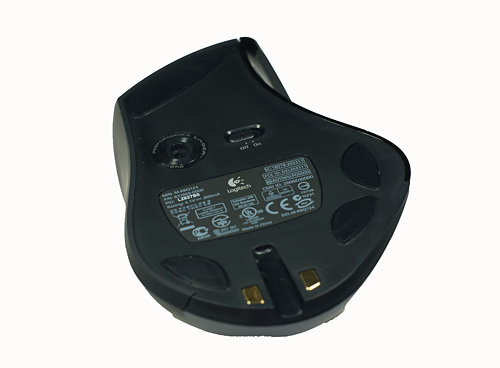
The bottom of the MX Revolution is fairly ordinary. There are four low-friction polytetrafluoroethylene (Teflon based) feet designed to reduce resistance and improve gliding across most surfaces. We found the new material on the feet allowed the Revolution to glide across our mouse pad or desktop surface a lot easier than previous Logitech offerings. In fact, the difference was noticeable the first time we used the mouse. There is an on/off switch for the unit and we suggest using it for additional power savings. The last area of interest is the sensor opening for the optical sensor. Although rated at 800 dpi, which is lower than the 2000 dpi of Logitech's gaming mice, it proved to be just as accurate and flexible in everyday use. We never felt like there was a need to adjust the mouse's pointer speed and in some cases it seemed less jittery than our G5 during gaming and especially in Photoshop.
Logitech includes a sturdy stand for the mouse that doubles as the battery charging station. A small charging adapter, SetPoint software CD, and the USB 2.0 based receiver is also included in the package along with a brief instruction guide for setting up the mouse. The MX Revolution communicates wirelessly through the USB 2.0 receiver on the 2.4 GHz frequency band with an advertised range of up to 30 feet. In our testing we found the mouse worked perfectly up to 20 feet or so without lag or skips. We did manage to reach 30 feet but the operation was awkward at best with lag and jumpiness, especially when the microwave was turned on. The mouse itself is powered by an integrated Li-Ion battery, which is charged via contacts on the bottom when the mouse is placed in the mouse stand.
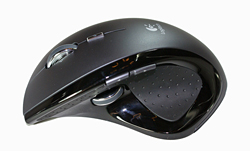 |
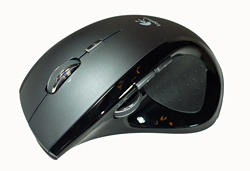 |
| Click to enlarge | |
The MX Revolution's most prominent design feature is the integrated thumb rest area. While other mice might have a similar area for the thumb or grooved recesses, the sculpted curve design of the Revolution feels perfectly natural. This entire area is molded with a rubber grip that has a nice tactile feel to it. While the number of buttons first appears to be minimal, the layout design conceals the fact that there are nine available button/wheel choices. The horizontal capable scroll wheel can be configured as three buttons (left, center, right). An additional button is located below the scroll wheel along with the two side buttons and document flip wheel, all of which are configurable. The last two are the right and left click buttons that are not configurable.
The MX Revolution weighs about the same as the MX1000 but its mass is located on the bottom side of the unit instead of up top like the MX1000. This mouse is noticeably heavier and larger than the corded gaming mice and feels like a solid chunk of expensive metal. However, the weight is not overbearing and the size of the mouse actually invokes a very comfortable feeling as we found ourselves being able to "palm" the mouse during gaming.
The revised design of the Revolution allowed our hands to fit comfortably and at times it seemed as if the mouse was tailored to our hand measurements. However, those with larger hands might find the thumb rest area to be slightly small and will have their thumbs pressed against the side wheel. We thought this would be an issue at first glance as the ability to accidentally click on this wheel could be a problem. It turned out not to be a worry as the side wheel requires a firm click or forward/backward movement to operate it. The two buttons located just above the thumb wheel are easy to access. They are just high enough to keep your thumb from accidentally clicking on them but close enough that a quick upwards flick of your thumb will operate both buttons.
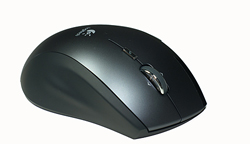 |
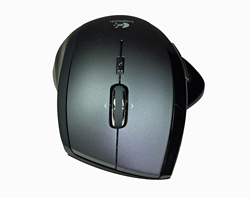 |
| Click to enlarge | |
The right side of the mouse has a slight indentation that allows the third finger to rest comfortably and allows for precise movements with the mouse. This side of the mouse is not coated with the same rubber but the plastic is molded to allow for a very comfortable feel that still has a slight grip to it. The forward section of the MX Revolution containing the right and left click buttons is sloped dramatically but its design ensures a relaxing position for the hand. The tactile feedback when clicking the right and left buttons were almost perfect in our opinion. It is obvious that Logitech placed an enormous amount of thought into the new shape, quality of materials, and overall mechanical operation of the mouse.

The bottom of the MX Revolution is fairly ordinary. There are four low-friction polytetrafluoroethylene (Teflon based) feet designed to reduce resistance and improve gliding across most surfaces. We found the new material on the feet allowed the Revolution to glide across our mouse pad or desktop surface a lot easier than previous Logitech offerings. In fact, the difference was noticeable the first time we used the mouse. There is an on/off switch for the unit and we suggest using it for additional power savings. The last area of interest is the sensor opening for the optical sensor. Although rated at 800 dpi, which is lower than the 2000 dpi of Logitech's gaming mice, it proved to be just as accurate and flexible in everyday use. We never felt like there was a need to adjust the mouse's pointer speed and in some cases it seemed less jittery than our G5 during gaming and especially in Photoshop.
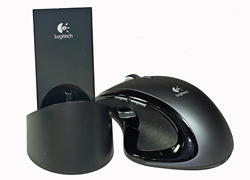 |
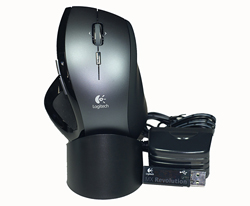 |
| Click to enlarge | |
Logitech includes a sturdy stand for the mouse that doubles as the battery charging station. A small charging adapter, SetPoint software CD, and the USB 2.0 based receiver is also included in the package along with a brief instruction guide for setting up the mouse. The MX Revolution communicates wirelessly through the USB 2.0 receiver on the 2.4 GHz frequency band with an advertised range of up to 30 feet. In our testing we found the mouse worked perfectly up to 20 feet or so without lag or skips. We did manage to reach 30 feet but the operation was awkward at best with lag and jumpiness, especially when the microwave was turned on. The mouse itself is powered by an integrated Li-Ion battery, which is charged via contacts on the bottom when the mouse is placed in the mouse stand.










38 Comments
View All Comments
JonnyDuke - Thursday, September 28, 2006 - link
Did you mean http://dictionary.reference.com/browse/tactical">tactical or http://dictionary.reference.com/browse/tactile">tactile??As for the mouse I am still of the mind that mice and keyboards should not require software to function. My own personal experience with Logitech's drivers has been spotty at best and I would rather not have to install them to use the mouse or keyboard primary functions.
Gary Key - Thursday, September 28, 2006 - link
Changed to tactile as it should have been in the first place. Sometimes DNS is not exactly perfect and we obviously missed it on the edit. Thanks to both of you for pointing it out. :)I am not a big fan of the mouse/keyboard software packages either. However, it almost seems they are required now to use of the new features.
slashbinslashbash - Thursday, September 28, 2006 - link
The word is "tactile", not "tactical." On Page 2:fanbanlo - Thursday, September 28, 2006 - link
Unlike MS's Intellipoint, it CANNOT detect which app is in focus and switch the customizable keys to another mapped key/function. This definately SUCKS big time, and I couldn't imagine that it is STILL not in SetPoint the mouse driver!Zoomer - Saturday, September 30, 2006 - link
You could try logigamer and see if that works for you.Gary, could you see if logigamer will work with this mouse? That will give it per app mouse button setting. :) http://www.logigamer.com/">http://www.logigamer.com/
Gary Key - Monday, October 2, 2006 - link
I will have an answer today.AnnihilatorX - Thursday, September 28, 2006 - link
It does detect games thoughI could drop the quick scroll button functions in my MX1000 and assign them functions in BF2
ninjit - Thursday, September 28, 2006 - link
Your experience with the new scrollwheel is exactly what I've been looking for.When the Apple mighty-mouse first came out this is the kinda of functionality i was expecting - being able to flick the ball in any direction, but unfortunately it's not really free spinning (not enough weight in the ball), and apple's mice really suck ergonomically for extended use for anything.
Now if only they'd drop the price, otherwise I expect this feature to take a while to trickle down to cheaper models.
Also must agree with the other comments about the review, nice change to see something more along the lines of (HCI) Human Computer Interaction.
And you did a great job describing your experience with something that essentially still boils down to personal preference rather than performance numbers.
kristof007 - Thursday, September 28, 2006 - link
I have been on Anandtech for about 3 years now and I haven't seen many mouse reviews. Great change of pace! I loved the review. I saw this at the store and it was rather nice although I cannot ditch my MX518. This mouse is just awesome. Period.Rollomite - Thursday, September 28, 2006 - link
I agree. I have yet to use a mouse that made me want to replace my MX518. I actually prefer the way that "the on the fly" DPI buttons on the MX518 are set up. I will admit, the adjustable weights on the newer models is nice, and tempting, but I think I'll wait til the MX craps out. I digress....